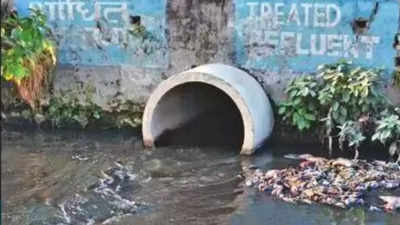- News
- City News
- nashik News
- Maharashtra industries tagged 'red' for pollution rise 26% in 5 years
Trending
Maharashtra industries tagged 'red' for pollution rise 26% in 5 years
Industries with high toxicity potential like thermal power plants and asbestos manufacturing units are closely monitored for pollution control. The Maharashtra Pollution Control Board implements strict measures to mitigate environmental impact and safeguard public health. Effective regulation of these industries is vital for sustainable development and ecological preservation.

Representative Image
KOLHAPUR: In just the past five years, large, medium and small industries, which have been put in the red category for causing high levels of pollution, have gone up by 26% across all 12 regions of Maharashtra, revealed the Economic Survey Report tabled in the state legislature.
Jagganath Salunkhe, the regional officer of the Maharashtra Pollution Control Board, Kolhapur said, "Pollution mitigation measures are adopted as per the categorisation.We emphasise on zero liquid discharge and zero emission by forcing the industries to set up the most advanced technologies without which, we do not renew the consent."
Salunkhe said the industries causing water pollution have to install common effluent treatment plants (CETPs). "We have started online monitoring of the pollution levels before and after effluent treatment. The industries are reluctant to set up advanced technology units to reduce pollution because of the expenses involved. However, we have made it mandatory to prevent pollution of water bodies. We encourage industries to adopt cleaner technologies," he added.

The state is divided into 12 MPCB regions. Of the 12, Pune region has the highest number of large "red" industries (1,302), followed by Nashik region (480), Mumbai region (360) and Chhatrapati Sambhajinagar region (349). Kolhapur region, which comprises Kolhapur, Ratnagiri, Sindhudurg and Sangli, has 314 large industries marked red, but it has the highest number of industries tagged white (7,145). The small-scale red units are provided financial aid to set up CETPs. In Maharashtra, 7,885 industries have installed CETPs treating 173 million litres of effluent per day.
In March this year, TOI had reported that Bombay high court directed Maharashtra Pollution Control Board (MPCB) to immediately begin a pollution audit of industries in the 'red' category, which have high toxicity potential.
It observed that air pollution issues raise broader public interest and concerns over "human cause".
Thermal power plans, large chemical industries, refineries and asbestos manufacturing units fall in the red category.
HC also suggested the establishment of a statutory pollution control commission comprising experts, scientists and bureaucrats to ensure timely and effective monitoring.
"Such a commission in MMR (Mumbai Metropolitan Region) is essential," said HC. There is one such in Delhi.
Chief Justice Devendra Kumar Upadhyaya and Justice Girish Kulkarni were hearing a suo moto PIL on air pollution in MMR. Advocate general Birendra Saraf presented a roadmap that has been prepared for a comprehensive audit.
Jagganath Salunkhe, the regional officer of the Maharashtra Pollution Control Board, Kolhapur said, "Pollution mitigation measures are adopted as per the categorisation.We emphasise on zero liquid discharge and zero emission by forcing the industries to set up the most advanced technologies without which, we do not renew the consent."
Salunkhe said the industries causing water pollution have to install common effluent treatment plants (CETPs). "We have started online monitoring of the pollution levels before and after effluent treatment. The industries are reluctant to set up advanced technology units to reduce pollution because of the expenses involved. However, we have made it mandatory to prevent pollution of water bodies. We encourage industries to adopt cleaner technologies," he added.

For industries flagged red, the consent to operate must be taken from MPCB once in five years. For orange industries, the consent is required once in 10. Similarly, for industries in the green, consent is required once every 15 years, while white-tagged industries, which are non-polluting, do not need MPCB consent as per the CPCB guidelines.
The state is divided into 12 MPCB regions. Of the 12, Pune region has the highest number of large "red" industries (1,302), followed by Nashik region (480), Mumbai region (360) and Chhatrapati Sambhajinagar region (349). Kolhapur region, which comprises Kolhapur, Ratnagiri, Sindhudurg and Sangli, has 314 large industries marked red, but it has the highest number of industries tagged white (7,145). The small-scale red units are provided financial aid to set up CETPs. In Maharashtra, 7,885 industries have installed CETPs treating 173 million litres of effluent per day.
In March this year, TOI had reported that Bombay high court directed Maharashtra Pollution Control Board (MPCB) to immediately begin a pollution audit of industries in the 'red' category, which have high toxicity potential.
It observed that air pollution issues raise broader public interest and concerns over "human cause".
Thermal power plans, large chemical industries, refineries and asbestos manufacturing units fall in the red category.
HC also suggested the establishment of a statutory pollution control commission comprising experts, scientists and bureaucrats to ensure timely and effective monitoring.
"Such a commission in MMR (Mumbai Metropolitan Region) is essential," said HC. There is one such in Delhi.
Chief Justice Devendra Kumar Upadhyaya and Justice Girish Kulkarni were hearing a suo moto PIL on air pollution in MMR. Advocate general Birendra Saraf presented a roadmap that has been prepared for a comprehensive audit.
End of Article
FOLLOW US ON SOCIAL MEDIA










